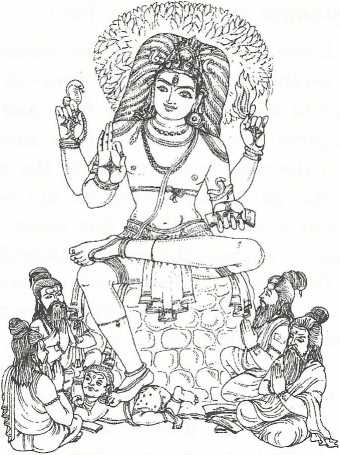Talk:Dakshinamurti
Dakṣiṇāmurti (‘form [facing] south’) Though God is one, he assumes three aspects when engaged in the process of sṛṣṭi (creation), sthiti (preservation) and pralaya (destruction). They are: Brahmā, Viṣnu and Śiva (Rudra or Maheśvara). Out of the several forms of Śiva described in the purāṇas and the āgamas, the Dakṣiṇāmṅrti is also one. It is a benign aspect of his. Since he was facing south (dakṣiṇa = south) at the time of teaching the sages in a secluded spot in the Himālayas, he came to be known as Dakṣiṇāmṅrti. Sometimes the word ‘dakṣiṇā’ is interpreted as jñāna, knowledge or wisdom, in which case he represents the very personification of knowledge and wisdom.
He is shown with three eyes, four arms and two legs and is seated under banyan tree. Two of the hands (the front right and the front left) are showing jñānamudrā and varadamudrā, postures of imparting knowledge and giving gifts respectively. In the other two hands—the back ones—he is holding the akṣamālā (rosary) and agni (fire) or a serpent. Sometimes he is pictured as playing on a Vīṇā or lute. Other texts portray him as holding a paraśu (axe) and harmī (ante-lope) instead of the rosary and fire. One of the legs is trampling upon the apasmārapuruṣa (cretinous person) signi¬fying ignorance. The tāntrik works describe him as white in complexion. He may be shown as surrounded by several ṛṣis or sages eager to learn spiritual wisdom from him. Several forms of Dakṣiṇāmurti are also described in the tāntrik works. Some of them are: Sarnhāra-Dakṣiṇāmurti, Lakuṭi-Dakṣiṇāmurti, Medhā-Dakṣiṇā¬murti, Sāmba-Dakṣiṇāmurti and so on. Each one of these is, iconographically speaking, sculptured in a different manner. His worship may involve elaborate rituals. His yantra (magical diagram) is a lotus with eight petals on which the deities Brahmā, Sarasvatī, Gaṇapati and some sages are inscribed. See also ŚIVA.

